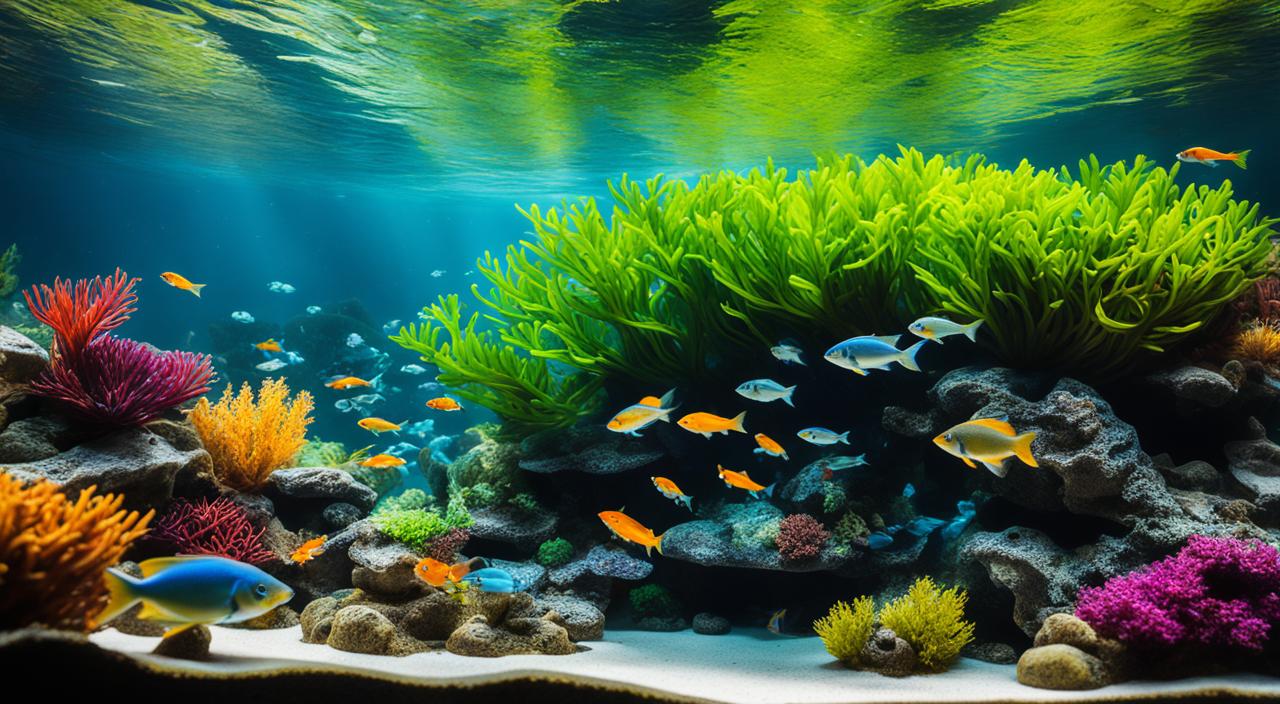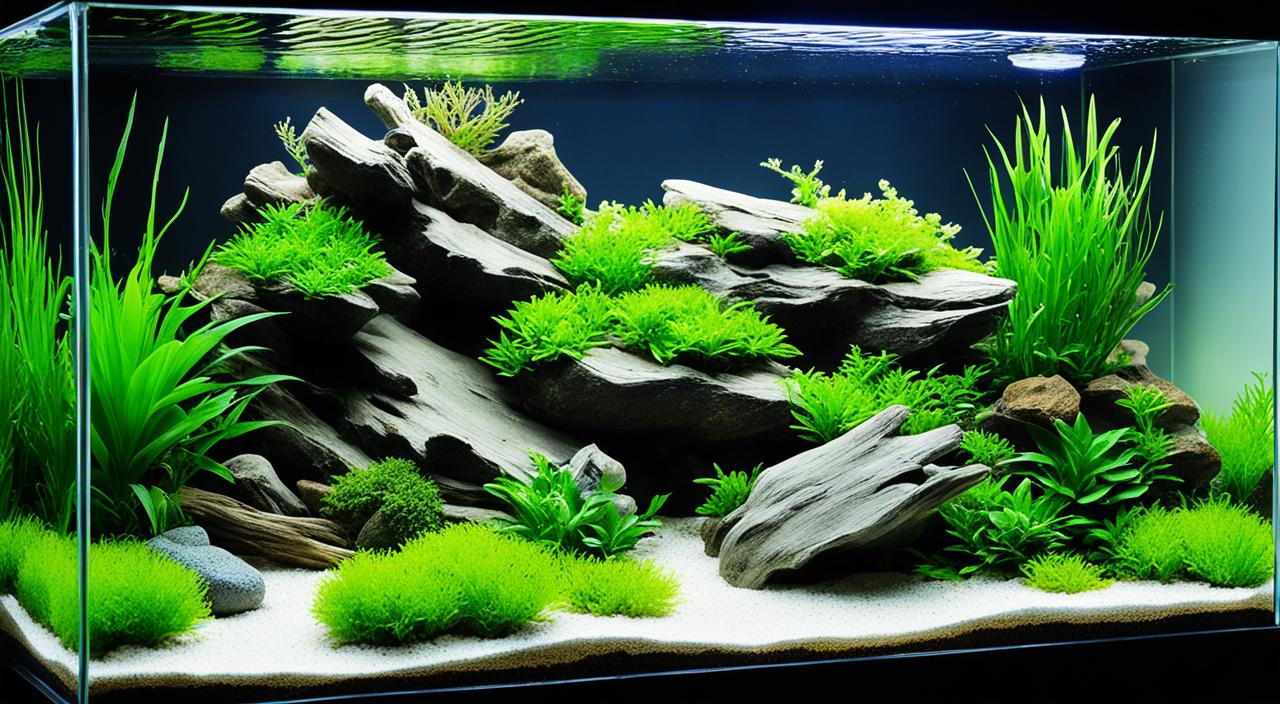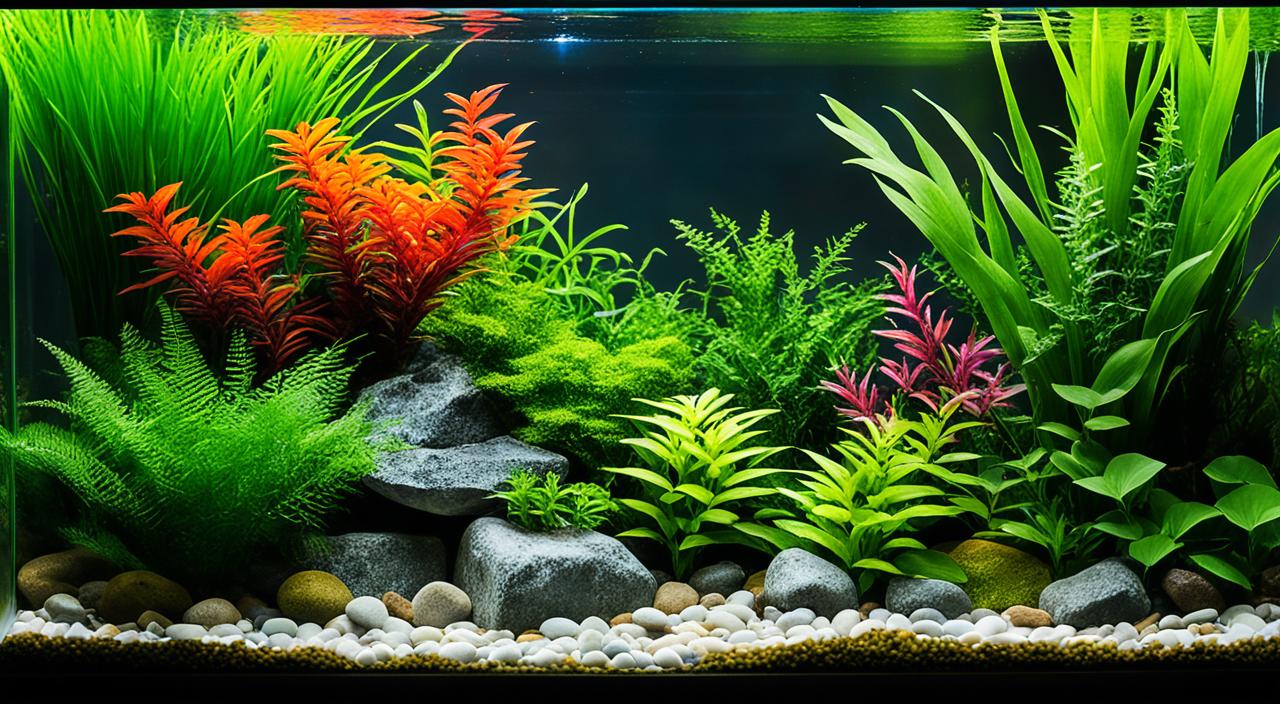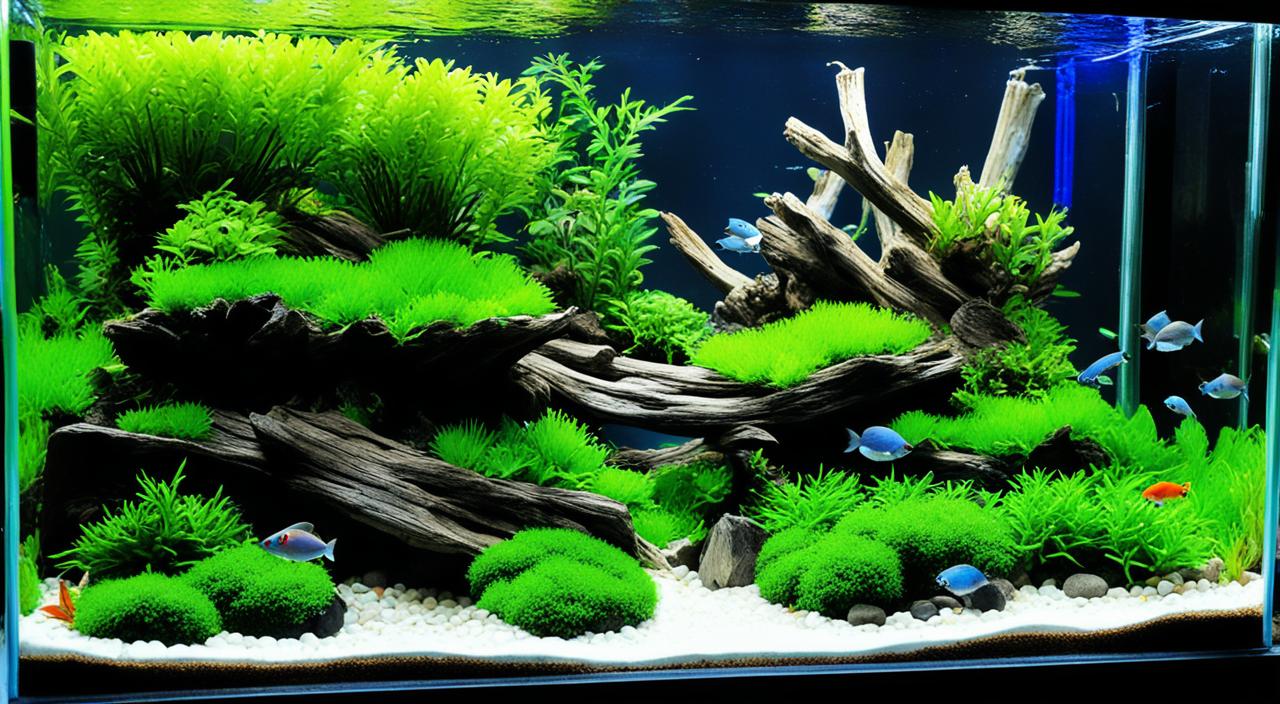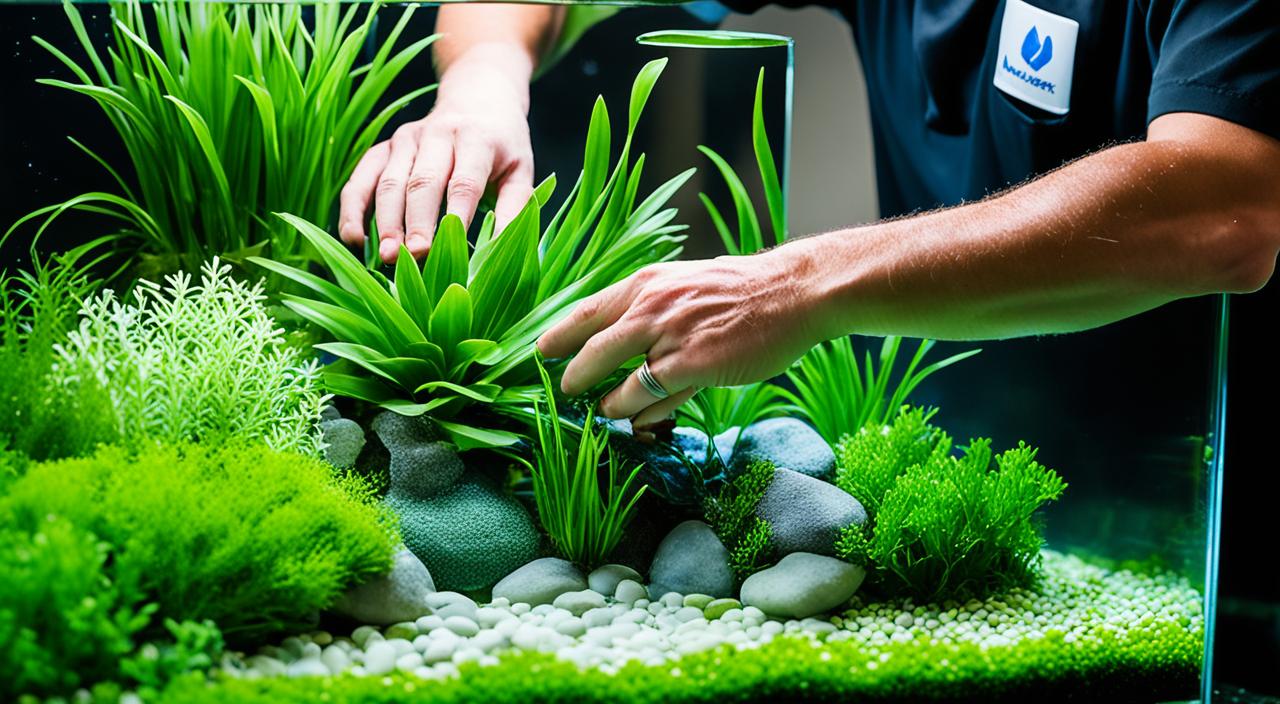Welcome to the world of aquascaping, where art and nature come together to create stunning underwater landscapes. Whether you’re a beginner aquascape or someone looking to expand your skills, this comprehensive guide will walk you through the basics of aquascaping and help you create your underwater paradise.
Aquascaping is an art form that involves arranging rocks, driftwood, and live plants in an aquarium to create visually appealing and natural-looking underwater scenes. It’s a combination of creativity, design principles, and horticultural knowledge. Aquascaping aims to create a piece of living art that showcases the beauty of aquatic plants and hardscape elements.
When it comes to aquascaping, there are a few fundamental principles to keep in mind. First, avoid symmetry. Natural scenes in nature are rarely perfectly symmetrical, so creating a sense of asymmetry in your aquascape is essential. This will make it look more realistic and visually pleasing.
Focal points are another essential aspect of aquascaping. A focal point is a visually striking element that draws the viewer’s eye. It could be a particularly beautiful plant, an interesting rock formation, or a unique piece of driftwood. Carefully placing focal points in your tank will help create depth and visual interest.
The rule of thirds and the golden ratio are concepts borrowed from photography and design that can be applied to aquascaping. You can create a balanced and visually pleasing composition by dividing your tank into thirds vertically and horizontally. The golden ratio, a mathematical ratio found in nature, can also create harmonious proportions in your aquascape.
Another critical aspect of aquascaping is considering the foreground, midground, and background. You can create depth and dimension in your tank by carefully selecting and positioning plants and hardscape elements. This will help create a sense of scale and make your aquascape look more natural.
Choosing the right plants is crucial for a successful aquascape. Consider factors like tank size, style of aquascape, and the placement of plants when selecting species. Each plant has different lighting, CO2, and nutrient requirements, so choosing plants that will thrive in your specific setup is essential.
Hardscape elements like rocks and driftwood are the backbone of any aquascape. They provide structure and help create your design’s overall shape and form. The choice of hardscape materials will depend on the style of aquascape you’re aiming for, whether it’s a nature aquarium or an Iwagumi-style layout.
With so many different styles, it can be overwhelming to decide where to start. The nature aquarium style, popularized by aquascaping pioneer Takashi Amano, aims to recreate natural landscapes in miniature form. On the other hand, the Dutch style focuses on neatly arranged and colourful aquatic plants.
Take your time to explore different aquascaping styles and find inspiration from experienced aquascapers. Don’t be afraid to mix and match elements from different styles to create a unique aquascape that reflects your personality and creativity.
Key Takeaways:
- Aquascaping is the art of arranging rocks, driftwood, and live plants in an aquarium to create visually appealing underwater landscapes.
- Avoid symmetry and create focal points to make your aquascape look natural and visually attractive.
- Consider the rule of thirds and the golden ratio to create balanced compositions in your aquascape.
- Foreground, midground, and background elements help create depth and dimension in your tank.
- Choose plants and hardscape materials that fit your style and consider their specific lighting, CO2, and nutrient requirements.
- Get inspired by different aquascaping styles and create your unique aquascape by combining elements from different styles.
What Is Aquascaping, Anyway?
Aquascaping is a captivating and creative art form that involves arranging plants, rocks, driftwood, and other natural materials in an aquarium. It goes beyond mere decoration, combining gardening, interior design, and pet care elements to create stunning underwater landscapes.
As a beginner aquascaper, getting started with aquascaping is an exciting journey filled with endless possibilities. You can transform your aquarium into a mesmerizing underwater paradise by exploring different styles and techniques.
There are various popular aquascaping styles, each offering a unique aesthetic and design approach. Let’s delve into some of these styles:
Nature Aquascaping
The nature aquascaping style, pioneered by the legendary Takashi Amano, focuses on recreating natural landscapes within the confines of an aquarium. It emphasizes lush plant growth, realistic rock formations, and a harmonious balance between flora and fauna. Nature aquascapes aim to evoke a sense of tranquillity and bring a slice of nature into your home.
Dutch Aquascaping
Dutch aquascaping is renowned for its vibrant and meticulously arranged aquatic plant layouts. It strives for colourful, eye-catching designs that showcase various plant species. Dutch aquascapes often feature well-defined terraces, creating a sense of depth and dimension. This style is perfect for aquascapers who appreciate precision and want to showcase a bountiful assortment of aquatic plants.
Iwagumi Style
Iwagumi style is characterized by its simplicity and focus on rock formations as key focal points. This Japanese-inspired style seeks to create visually striking compositions using carefully selected rocks, often arranged in odd numbers for aesthetic balance. Iwagumi aquascapes evoke a sense of zen and tranquillity, emphasizing the beauty of simplicity.
Jungle Style
Jungle-style aquascaping seeks to recreate the lushness and exuberance of a dense, tropical forest within an aquarium. It features abundant plants, with vines and foliage creating a captivating and immersive environment for your aquatic pets. The jungle style is perfect for those who enjoy nature’s wild, untamed beauty.
Biotope Style
Biotope-style aquascaping aims to replicate specific natural habitats, whether a serene riverbank, lake, or a vibrant coral reef. It involves meticulous research and attention to detail, recreating a particular ecosystem’s unique conditions, flora, and fauna. Biotope aquascapes provide a valuable educational opportunity by showcasing the wonders of nature in a confined space.
By exploring and experimenting with these different aquascaping styles, you can find inspiration for your unique creations. Remember, as a beginner aquascaper, starting aquascaping is all about unleashing your creativity, immersing yourself in the art form, and bringing your underwater dreams to life.
The Genesis of Aquascaping: A Brief History
Aquascaping, the art of creating underwater landscapes in aquariums, has a rich history that dates back to the early 20th century. The origins of aquascaping can be traced to the Dutch, who were among the first to experiment with aquatic plants in their aquarium setups. Dutch aquascaping, known as the Dutch style, became known for its lush and colourful aquatic plant arrangements arranged in terraces.
However, the visionary aquascaper Takashi Amano truly revolutionized the world of aquascaping in the 1980s. Amano, a Japanese artist and photographer, popularized the nature aquarium style, which aimed to recreate natural landscapes in miniature form. His intricate designs incorporated a harmonious blend of plants, hardscape elements, and aquatic life, creating stunningly realistic and captivating underwater scenes.
Takashi Amano’s nature aquarium style quickly gained popularity and became an inspiration for aquascapers around the globe. It emphasized using meticulously arranged plants to mimic the beauty and tranquillity of natural environments, resulting in breathtaking aquatic landscapes resembling miniature forests, mountains, and rivers.
Today, the Dutch style and Takashi Amano’s nature aquarium style remain influential in aquascaping. Aquascapers continue to draw inspiration from these styles while adding their creative twists. Whether you prefer the neatly arranged and colourful Dutch style or the naturalistic beauty of the nature aquarium style, aquascaping offers endless possibilities for creating captivating underwater worlds.
Below is an image of a nature aquarium-style aquascape showcasing the mesmerizing beauty and intricate design:
Stay tuned for the next section, where we’ll explore different types of aquascapes and help you choose the perfect style for your underwater masterpiece.
Types of Aquascapes: Choose Your Adventure
If you’re a beginner aquascaper looking to create your underwater paradise, exploring and understanding the different types of aquascapes is essential. Each style brings unique aesthetics and challenges, allowing you to choose the adventure that best suits your preferences and skill level. Here are some popular aquascaping styles for beginners:
Dutch Style Aquascapes
The Dutch-style aquascape is known for its colourful and meticulously arranged aquatic plants. This style emphasizes vibrant plant selection and strong lines to create a captivating and visually striking display. Dutch aquascapes often feature neatly trimmed and layered plantings, creating a manicured and pristine look.
Nature Style Aquascapes
The nature-style aquascape, popularized by renowned aquascaper Takashi Amano, seeks to recreate natural landscapes within the confines of an aquarium. This style focuses on dense plant growth and realistic rock formations, mimicking the beauty of nature. Nature aquascapes strive to balance plants, hardscapes, and livestock harmoniously.
Iwagumi Style Aquascapes
The Iwagumi-style aquascape revolves around the artful arrangement of rocks, with minimal use of plants and hardscape materials. This style aims for simplicity, utilizing a single rock composition as the focal point. Iwagumi aquascapes create a serene atmosphere, emphasizing clean lines and minimalistic design.
Jungle Style Aquascapes
Jungle-style aquascapes are all about lush and dense plant growth, resembling a vibrant, overgrown rainforest. This style often features a variety of plant species with cascading vines and leaves, creating a wild and untamed appearance. Jungle aquascapes promote a natural and chaotic aesthetic, perfect for those who appreciate a more organic look.
Biotope Style Aquascapes
Biotope-style aquascapes recreate specific natural habitats found in different parts of the world. From Amazonian riverbanks to African lakes, this style aims to replicate the look and feel of a particular ecological niche. Biotope aquascapes carefully consider plant selection, hardscape materials, and even the choice of livestock to represent the chosen environment accurately.
Each of these aquascaping styles offers a unique and captivating experience. Consider your preferences, available resources, and the level of commitment you are willing to invest in maintenance. By exploring different styles, you can embark on your aquascaping journey and create stunning underwater landscapes.
| Aquascape Style | Description |
|---|---|
| Dutch Style | Jungle aquascapes feature lush and overgrown plant growth, mimicking a rainforest’s vibrant and chaotic look. |
| Nature Style | Nature aquascapes recreate natural landscapes with dense plant growth and realistic rock formations for a harmonious and natural aesthetic. |
| Iwagumi Style | This minimalistic style focuses on artfully arranging rocks as the focal point, with clean lines and simplicity. |
| Jungle Style | This style replicates specific natural habitats, carefully considering plant selection, hardscape materials, and livestock to represent the chosen environment accurately. |
| Biotope Style | This style replicates specific natural habitats, carefully considering plant selection, hardscape materials, and livestock to accurately represent the chosen environment. |
Assessing Tank Size and Shape
When it comes to creating your aquascape, the size and shape of your aquarium play a crucial role in determining the type of design you can achieve. Whether you have a large or a small tank, each offers unique opportunities for creating a stunning underwater paradise.
Let’s start by discussing tank size. Larger tanks provide more space, allowing you to incorporate a greater variety of plants, rocks, and other elements into your aquascape. This means you can create more intricate and elaborate designs that captivate anyone who touches your aquarium. Additionally, larger tanks offer a more stable environment, benefiting aquatic plants and fish.
On the other hand, smaller tanks can still pack a punch regarding visual impact. A small tank can showcase a beautiful aquascape that rivals larger setups with the proper layout and design. It’s all about effective space utilization and creating a layout that maximizes the visual appeal within the given dimensions. So, don’t let the size of your tank discourage you from embarking on the aquascaping journey.
Now, let’s move on to substrate selection. The substrate is the material that lines the bottom of your aquarium and serves as the foundation for your plants. Choosing a suitable substrate is essential for creating a thriving aquatic ecosystem.
There are two main types of substrates to consider: inert and nutrient-rich. Inert substrates, such as sand or gravel, do not offer any additional nutrients to your plants. They provide a stable base for your aquascape. Inert substrates are commonly used in low-tech setups or in aquascapes where you plan to rely on liquid or root fertilizers.
On the other hand, nutrient-rich substrates, like specialized aquatic plant substrates or soil substrates, provide essential nutrients for your plants to thrive. These substrates are packed with nutrients such as iron, potassium, and nitrogen, which are crucial for healthy plant growth. Nutrient-rich substrates are often used in high-tech setups or aquascapes aiming for lush, densely planted environments.
To determine the best substrate for your aquascape, consider factors such as the style of your aquascape, the types of plants you want to incorporate, and your experience in aquatic gardening. It’s essential to research and understand the specific needs of your chosen plants to ensure they receive the proper nutrients and growing conditions.
Remember, the size and shape of your tank and the substrate you choose are essential in creating your ideal aquascape. So, take the time to plan and select the options that align with your vision and goals. By doing so, you’ll be on your way to creating a breathtaking underwater oasis.
| Pros of Larger Tanks | Pros of Smaller Tanks |
|---|---|
| More space for design creativity | Can create impactful designs with the right layout |
| It provides a more stable environment | Easier to maintain and clean |
| Can create impactful designs with the proper layout | Less expensive to set up and maintain |
| Great for showcasing intricate and elaborate designs | Can fit into smaller spaces |
When it comes to substrate selection, there are two main options to consider:
- Inert Substrates: Provide a stable base without additional nutrients. Suitable for low-tech setups or when relying on liquid or root fertilizers.
- Nutrient-Rich Substrates: Packed with essential nutrients for healthier plant growth. Used in high-tech setups or to achieve lush, densely planted environments.
Choosing a Style
When it comes to aquascaping, choosing the right style is essential. Not only does it reflect your taste, but it also sets the overall mood and theme of your underwater paradise. Finding the perfect aquascaping style can be exciting and overwhelming for a beginner. But fret not, as this section will guide you through selecting a style that suits your preferences, tank size, and shape.
The first step in choosing a style is researching different aquascaping styles that resonate with you. Explore online forums, social media platforms, and aquascaping communities to gain inspiration from experienced aquascapers. Look for examples of aquascapes that catch your eye, and take note of the elements that appeal to you the most.
Consider your tank’s size and shape when selecting a style. Certain styles, such as the Dutch or nature styles, may require a larger tank to showcase their beauty fully. On the other hand, smaller tanks can still accommodate styles like Iwagumi or jungle style, where the focus is on specific elements rather than overall lushness.
Don’t be afraid to mix and match elements from different styles to create a unique aquascape that reflects your personality. Aquascaping is an art form that allows for creativity and experimentation. By combining different techniques and elements, you can create a truly your own style.
To help you visualize the different aquascaping styles and their characteristics, take a look at the table below:
| Aquascaping Style | Description |
|---|---|
| Dutch Style | Aquascape focuses on rock arrangements and simplicity |
| Nature Style | Aquascape that aims to recreate natural landscapes with dense plant growth and realistic rock formations |
| Iwagumi Style | Aquascape that focuses on rock arrangements and simplicity |
| Jungle Style | Aquascape featuring dense plant growth and overgrown vines |
| Biotope Style | Aquascape that recreates specific natural habitats |
Now that you better understand the different aquascaping styles, it’s time to choose the one that speaks to you. Remember, the key is to have fun and let your creativity flow. Happy aquascaping!
Plan Your Aquascape: Measure Twice, Plant Once
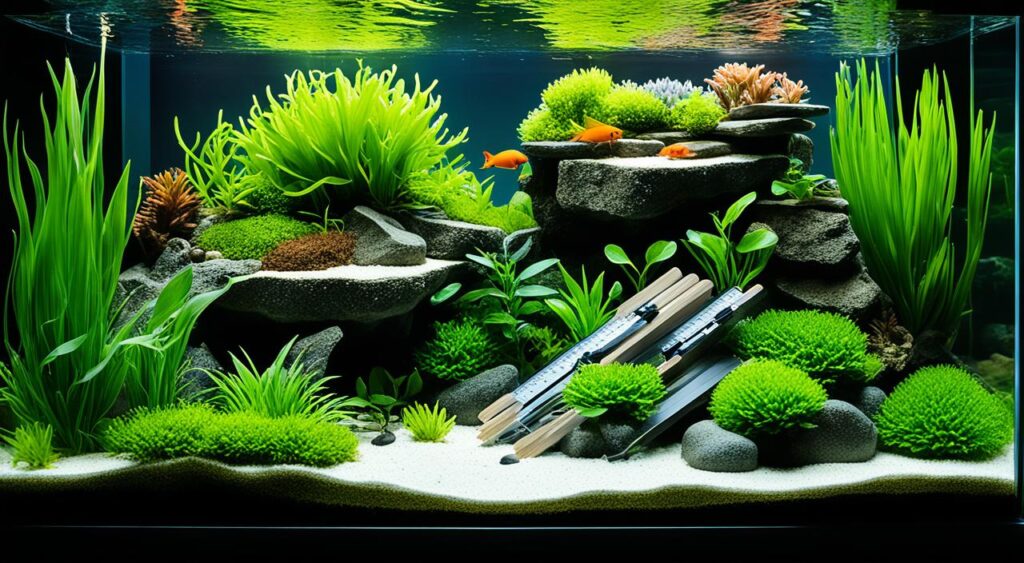
Before diving into your aquascape project, taking the time to plan and visualize your design is crucial. You can ensure a successful and aesthetically pleasing aquascape by carefully considering key elements such as the focal point, rule of thirds, and creating depth.
Start by identifying the focal point of your aquascape. This area or feature of your design will draw the most attention. It could be a striking rock formation, a beautifully coloured plant, or a captivating piece of driftwood. Place the focal point strategically to create visual interest and balance within the aquarium.
Next, embrace the rule of thirds. This principle involves visually dividing your aquascape into nine equal parts using two equally spaced horizontal lines and two equally spaced vertical lines. Positioning key elements like rocks, plants, or hardscape materials along these lines or at their intersections can create a composition that is pleasing to the eye.
To add depth and dimension to your aquascape, utilize different substrate layers and vary the heights of your hardscape materials. You can achieve a natural and visually engaging design by creating gradual transitions from foreground to background and playing with levels.
When selecting plants for your aquascape, choose species that fit your desired style and have growth requirements that align with your tank’s conditions. Consider lighting, CO2 injection, and nutrient demands to ensure optimal plant health and growth.
If visualizing your design on paper or a digital platform helps you plan and experiment with different layouts, consider using sketching or aquascaping apps. These tools can help you map out your design, make adjustments, and determine the placement of each element before implementation.
Remember, careful planning and consideration are key when it comes to aquascaping. By measuring twice, planning thoroughly, and visualizing your design, you can set yourself up for success and create a stunning aquascape that brings your underwater paradise to life.
Plant Selection
Selecting the right plants is a crucial step in creating a stunning aquascape. Consider the following factors when choosing your aquatic plants:
- Colour: Choose plants with vibrant colours to add visual interest and create a captivating underwater scene.
- Texture: Look for plants with different leaf shapes and textures to provide depth and dimension to your aquascape.
- Growth Patterns: Research and select plants with growth patterns that complement your desired style. Some plants may grow tall and create vertical accents, while others may spread and cover the substrate.
- Size and Placement: Consider the size of the plants and how they will fit in your tank. Place taller plants towards the back and shorter plants towards the front for a balanced and visually appealing layout.
- Style of Aquascape: Align your plant selection with the aquascape you aim for. Different styles may require specific types of plants to achieve the desired look.
- Care Requirements: Consider the care you can provide for the plants. Some plants may require high light intensity, CO2 supplementation, or nutrient-rich substrate to thrive.
Consider lighting, CO2 injection, and nutrient requirements when choosing your aquatic plants. This careful selection will ensure that your plants not only enhance the visual appeal of your aquascape but also thrive and contribute to a healthy ecosystem in your aquarium.
Aquatic Plants Guide
Below is a comprehensive list of popular aquatic plants that are suitable for aquascaping:
| Common Name | Scientific Name | Plant Care Difficulty | Lighting Requirements |
|---|---|---|---|
| Anubias | Anubias spp. | Easy | Low to moderate |
| Java Fern | Microsorum pteropus | Easy | Low to moderate |
| Cryptocoryne | Cryptocoryne spp. | Easy to moderate | Low to moderate |
| Dwarf Hairgrass | Eleocharis parvula | Easy | High |
| Eleocharis acicularis | Eleocharis acicularis | Easy | High |
| Staurogyne Repens | Staurogyne repens | Easy | Staurogyne repens |
| Rotala Indica | Rotala indica | Easy to moderate | Moderate to high |
These are just a few examples of aquatic plants suitable for aquascaping. Each plant has its unique characteristics and care requirements, so be sure to research and choose the plants that align with your vision and level of expertise.
Lighting Requirements
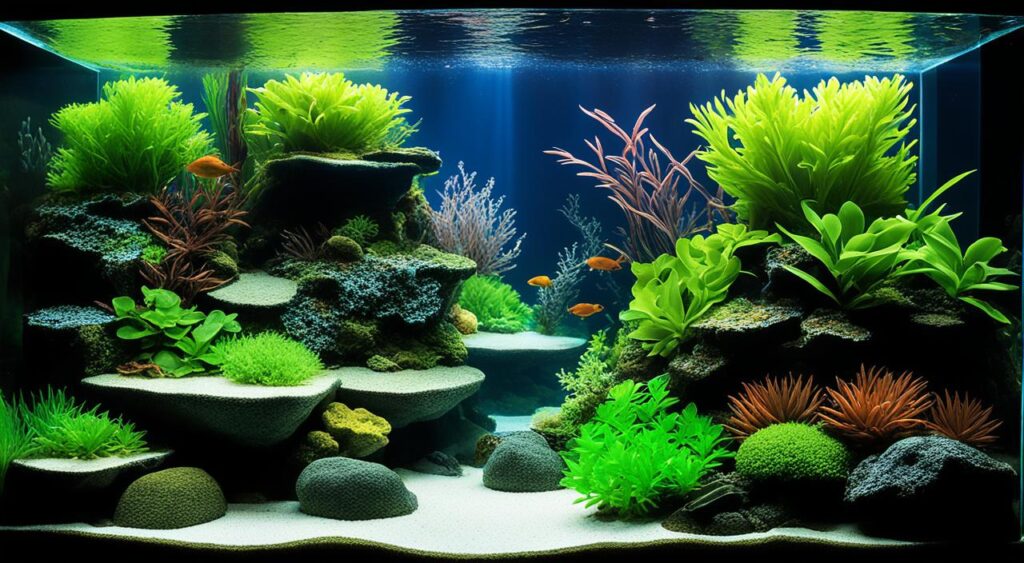
Proper lighting is essential for the healthy growth of your aquascape plants. Different plants have different lighting requirements, and it’s essential to research and understand the specific needs of your chosen plants. Providing the appropriate intensity and duration of light will ensure optimal plant growth and development.
One popular option for aquascape lighting is LED lights. LED lights offer energy efficiency, customizable light spectrums, and a long lifespan. They provide a balanced light distribution across the aquarium, promoting healthy photosynthesis for your plants.
When setting up your aquascape, consider the placement of the lighting fixtures to ensure proper coverage for all plants. Avoid creating shadows or areas of excessive brightness that could affect plant growth.
It’s also important to note that the duration of light exposure should mimic natural lighting conditions. Most aquarium plants require 8-10 hours of light per day. Using a timer for your lighting system will help automate this process and provide consistent lighting for your aquascape.
CO2 and Nutrient Supplementation
Proper water chemistry is crucial for the health and growth of aquatic plants in an aquascape. Some plants may require additional CO2 and nutrient supplementation to thrive. Understanding your chosen plants’ needs and providing the necessary CO2 and nutrients is essential for their overall well-being.
CO2 injection systems can be used to supplement carbon dioxide levels in the aquarium, which is essential for plant photosynthesis. This can be achieved by using CO2 regulators and diffusers, ensuring a steady supply of CO2 to support plant growth.
Additionally, fertilizers provide the necessary nutrients that may be lacking in the aquarium water. You can choose between liquid fertilizers or root tabs, depending on the specific needs of your plants. These fertilizers typically contain macronutrients such as nitrogen, phosphorus, potassium, and micronutrients like iron and magnesium.
It is important to note that water chemistry is a delicate balance, and maintaining proper levels of CO2 and nutrients requires regular monitoring and adjustments. Testing the water parameters using test kits can help you determine the appropriate dosage and ensure that your plants receive the necessary elements for optimal growth.
| CO2 and Nutrient Supplementation Tips |
|---|
| 1. Research the specific CO2 and nutrient requirements of your chosen plant species. |
| 2. Use CO2 injection systems, such as regulators and diffusers, to supplement carbon dioxide levels. |
| 3. Choose fertilizers that provide the necessary macronutrients and micronutrients for plant growth. |
| 4. Test the water parameters regularly using test kits to ensure proper CO2 and nutrient levels. |
| 5. Make adjustments as needed to maintain a healthy and thriving aquascape. |
Hardscape
In aquascaping, the hardscape is an essential element that provides structure and sets the tone for the overall design. It encompasses rocks and driftwood, crucial in creating a visually appealing and balanced aquascape. As a beginner, understanding how to incorporate hardscape materials effectively can help you achieve stunning results in your DIY aquascaping projects.
When choosing rocks and driftwood for your aquascape, consider the shape and form you want to create. Select materials that complement your chosen style, whether a nature aquarium, Dutch style, Iwagumi style, or any other design concept. The hardscape materials’ size, colour, and texture should be thoughtfully chosen to enhance the overall composition of the aquascape.
Rocks can create focal points and exciting features within the tank. They can be stacked, arranged in clusters, or positioned strategically to draw the eye and create depth in the aquascape. On the other hand, Driftwood adds a natural and organic element to the design. Depending on your creativity and the desired aesthetic, it can be used to create tree-like structures, caves, or intricate branch patterns.
Remember that positioning the hardscape in the aquarium should be done carefully, keeping in mind the guidelines of the chosen style. Properly arranging the rocks and driftwood will help create a harmonious and visually appealing layout.
| Hardscape Material | Characteristics |
|---|---|
| Seiryu Stone | An exceptionally lightweight sandstone type and features unique shapes and textures. It is reddish-brown and often has intricate patterns resembling dragon scales. |
| Ohko Stone (Dragon Stone) | A hardwood that is typically dark brown with intricate patterns and textures. It releases tannins into the water, giving it a natural tea-like colour. |
| Spider Wood | A type of driftwood with thin branches and a distinctive, twisted appearance. It adds a dynamic and artistic touch to aquascapes. |
| Mopani Wood | A hardwood that is typically dark brown with intricate patterns and textures. It releases tannins into the water, giving it a natural tea-like color. |
Choosing the suitable hardscape materials and incorporating them effectively will elevate the visual impact of your aquascape. Experiment with combinations and arrangements to find the perfect balance and create a captivating underwater landscape.
Creating a Layout
Now that you have carefully selected your plants and gathered the perfect hardscape materials, it’s time to bring your aquascape design to life by creating a layout that showcases your creativity and style.
Follow your plan and start arranging the elements in your tank according to the desired design. Remember to consider the focal points and strategically place them to draw the viewer’s attention. Use the rule of thirds to achieve a visually balanced composition.
Creating balance and visual interest in your aquascape is essential. Experiment with different arrangements, heights, and angles until you achieve the desired layout and composition. Take your time, and don’t be afraid to make adjustments.
FAQ
What is aquascaping?
Aquascaping is the art of arranging rocks, driftwood, and live plants in an aquarium to create visually appealing underwater landscapes. It involves meticulous planning and attention to detail, aiming to create a piece of art focusing on the plants and hardscape rather than the livestock.
How do I avoid symmetry in aquascaping?
Avoiding symmetry is important in aquascaping to create a natural-looking and aesthetically pleasing scene. Instead, you can use the rule of thirds and the golden ratio to create a balanced and visually appealing composition.
What are the important elements to consider in aquascaping?
The foreground, midground, and background are important elements to consider when placing plants and hardscape in the tank. They help to create depth and dimension in the aquascape.
What are some popular aquascaping styles?
Some popular aquascaping styles include Dutch style, nature style, Iwagumi style, jungle style, and biotope style. Each style offers a unique aesthetic and requires different techniques and plant selections.
How do I choose the right plants for my aquascape?
When choosing plants, consider their color, texture, and growth patterns. Research the size of plants and their placement in the tank. Take into account the style of aquascape and the level of care you can provide. Lighting and nutrient requirements are also important factors to consider.
What is the role of hardscape in aquascaping?
Hardscape, such as rocks and driftwood, is the backbone of any aquascape. It helps to create the overall shape and form of the design. Hardscape also provides structure and can be used to create focal points and interesting features in the tank.
How should I create the layout for my aquascape?
Before starting the aquascape, it is important to plan and visualize the design. Consider the focal point, follow the rule of thirds, and create depth by using different layers of substrate and varying heights of hardscape materials. Use sketching or aquascaping apps to map out your design before implementation.

